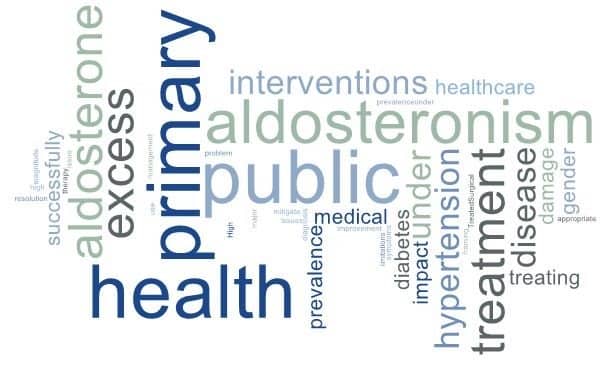PA is Under-Treated
Surgical treatment offers significant improvement, if not complete resolution of symptoms, in 35% of patients affected by primary aldosteronism. In the remaining 65%, medical therapy helps mitigate the damage caused by excess aldosterone. Yet, 95% of those affected are never diagnosed or treated. Regardless of the limitations of current diagnosis and treatment modalities, appropriate management of the disease calls for an appropriate framing of the problem: excess aldosterone is a major public health issue.

High Prevalence
Under-use of available means is compounded by high prevalence: up to 40 million people in the US and a billion worldwide. Medical issues of this magnitude are, by definition, public health issues. Their resolution requires concerted efforts only public health agencies can successfully deploy and monitor.
Wide-Ranging Damage
Excess aldosterone is associated with at least a dozen other diseases, some of which are fatal. By mitigating conditions such as diabetes and chronic heart failure, timely treatment of primary aldosteronism is de facto a preventative public health measure. More importantly, since it is now known that excess aldosterone is actually a primary cause of hypertension, treating hyperaldosteronism helps adequately address another major public health issue – essential hypertension.
Dietary Sodium
Despite being well-known, the role of dietary sodium in hypertension is not systematically emphasized. The cardiovascular damage of excess aldosterone is largely driven by inappropriate levels of sodium. Public health interventions are needed not only to promote healthy choices, but to make them the easiest choices. Successfully addressing the importance of dietary sodium requires interventions on a scale comparable to that of smoking cessation measures.
Racial and Gender Factors
Not only are African Americans at higher risk of developing hypertension, they are more likely to develop primary aldosteronism. Yet, they receive poorer healthcare, and are largely underrepresented in clinical trials. The impact of gender on the disease is equally critical. For example, when present during pregnancy, it causes maternal and fetal complications. These factors remain largely overlooked, and warrant proper interventions at the public health level.
Healthcare Spending
The wider socio-economic costs of under-treating primary aldosteronism are as damaging as its distressing impact on individuals, families, and communities. Adrenal venous sampling and adrenalectomies may come at a price for healthcare systems, and while more affordable, medical treatment is less effective. However, when taking prevalence and burden of disease into consideration, the financial consequences of under-treating primary aldosteronism far exceed those of available options. In the US alone, the cost of cardiovascular disease was estimated at $363 billion from 2016 to 2017, and the total cost of diabetes reached $327 billion in 2017.
References
- Funder, J. W. (2016). Primary aldosteronism as a public health issue. The Lancet Diabetes & Endocrinology, 4(12), 972-973.
- Libianto, R., Fuller, P. J., Young, M. J., & Yang, J. (2020). Primary aldosteronism is a public health issue: challenges and opportunities. Journal of Human Hypertension, 34(7), 478-486.
- US Centers for Disease Control and Prevention. (2023, March 23). Health and economic costs of chronic diseases. https://www.cdc.gov/chronicdisease/about/costs/index.htm.
- Dieleman, J. L., Cao, J., Chapin, A., Chen, C., Li, Z., Liu, A., Horst, C., Kaldijan, A., Matyasz, T., Woody Scott, K., Bui, A. L., Campbell, M., Duber, H. C., Dunn, A. C., Flaxman, A. D., Fitzmaurice, C., Naghavi, M., Sadat, N., Shieh, P., Squires, E., Yeung, K, & Murray, C. L. (2020). US health care spending by payer and health condition. JAMA, 323(9), 863-884.
- Hundemer, G. L., Curhan, G. C., Yozamp, N., Wang, M., & Vaidya, A. (2018). Cardiometabolic outcomes and mortality in medically treated primary aldosteronism: a retrospective cohort study. The Lancet Diabetes and Endocrinology, 6(1), 51-59.
- Milliez, P., Girerd, X., Plouin, P-F., Blacher, J., Safar, M. E., & Mourad, J. J. (2005). Evidence for an increased rate of cardiovascular events in patients with primary aldosteronism. Journal of the American College of Cardiology, 45(8), 1243-1248.
- Rifkin, D. E., Khaki, A. R., Jenny, N. S., McClelland, R. L., Budoff, M., Watson, K., Ix, J. H., & Allison, M. A. (2014). Association of renin and aldosterone with ethnicity and blood pressure: the multi-ethnic study of atherosclerosis. American Journal of Hypertension, 27(6), 801–810.

